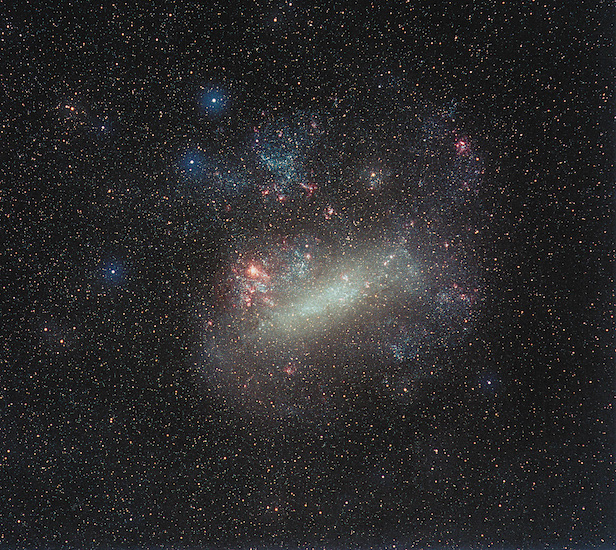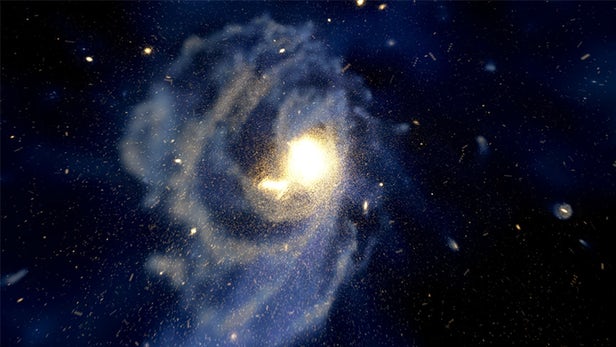Astronomers could have identified a star from outside the Milky Way
Analysis of the star’s chemical composition indicates that it could have originated from a dwarf galaxy that then merged with the Milky Way

The Large Magellanic Cloud is a dwarf galaxy that is a satellite to the Milky Way. Image credit: Eckhard Slawik
Using the High Dispersion Spectrograph on the Subaru Telescope, located on the summit of Mauna Kea, Hawaii, astronomers have discovered a star in the Milky Way galaxy with a chemical composition unlike any other star in our galaxy. This chemical composition has been seen in a small number of stars in dwarf galaxies orbiting the Milky Way. This suggests that the star was part of a dwarf galaxy that merged into the Milky Way.
The Milky Way galaxy has the so-called halo structure around the disk. The sparse structure of old stars has been formed in the early phase of the galaxy formation. The structure includes stars formed in gas clouds in the growing large galaxy and also those formed in small stellar systems that have accreted onto the galaxy. Such a scenario is predicted by computer simulation of galaxy formation assuming cold dark matter.
The small stellar systems accreted onto the galaxy, which would be similar to dwarf galaxies found in the current Universe, should have already been disintegrated in the space. However, individual stars should preserve the orbital motion in the galaxy and their chemical abundance ratios that were determined before the accretion. The focus of current studies in this field is to find evidence for such a scenario of galaxy formation by observations of individual stars in the Milky Way.
The star formation in dwarf galaxies is relatively slow compared to larger galaxies, resulting in difference in chemical abundance ratios recorded in stars. For instance, the magnesium to iron (Mg/Fe) abundance ratios in stars of dwarf galaxies currently found around the Milky Way show a clear difference from those of the bulk of Milky Way stars.

Computer simulation of formation of a spiral galaxy like the Milky Way, The halo structure is at least partially formed by the accretion of many small galaxies. Image credit: Takayuki Saito/Takaaki Takeda/Sorahiko Nukatani/4D2U Project/ NAOJ
A team of astronomers from the National Astronomical Observatory of Japan (NAOJ), National Astronomical Observatories of China (NAOC), and other institutes have selected stars in the Milky Way that have a relatively low amount of metal from the spectroscopic survey conducted with LAMOST survey telescope and applied High Dispersion Spectrograph (HDS) on the Subaru Telescope to measure detailed chemical abundances by Japan-China collaboration since 2014. The team has obtained chemical abundances for more than 400 stars, among which one object, J1124+4535, was identified to have remarkable abundance ratios.
This observation with the Subaru Telescope has revealed its extremely high abundance ratios of elements heavier than iron, as well as a quite low Mg/Fe ratio. The abundance pattern of these heavy elements clearly shows that its origin is an explosive nucleosynthesis, which is when elements heavier than iron capture other neutrons to form other elements. Whereas the abundance ratios of Fe/H and Mg/H are 1/20 and 1/40 of the solar ones, respectively, the abundance ratio of europium (Eu), which is a good indicator of heavy elements made by explosive nucleosynthesis, is as high as the solar value.
This is the first discovery of a star having such extreme abundance ratios among Milky Way stars. On the other hand, several examples of stars having similar abundance ratios are known in dwarf galaxies. This result suggests that this star has formed in a dwarf galaxy, and has accreted onto the Milky Way in the process of galaxy formation. The abundance ratios of this star provide the clearest signature of merger events of dwarf galaxies in stellar chemical abundances known to date.
An important result found in the abundance pattern of this object is that this star is similar to relatively metal-rich (less metal-poor) stars found in stars of dwarf galaxies. This indicates that the accreted dwarf galaxy had already chemically evolved at the time of accretion. Namely, the merging events of dwarf galaxies in the formation of the halo structure continued with timescale comparable to dwarf galaxy evolution, which support the current galaxy formation scenario predicted by simulation.
Try 5 issues of All About Space for just £5! Hurry though, offer ends soon.

Keep up to date with the latest news in All About Space – available every month for just £4.99. Alternatively you can subscribe here for a fraction of the price!




